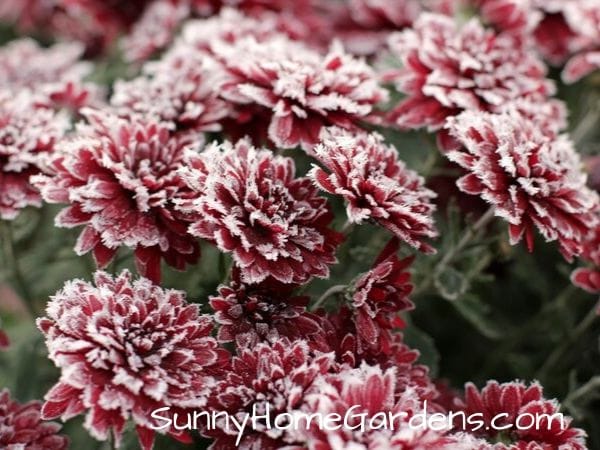Planting Chrysanthemums can brighten up any garden. Chrysanthemums are considered the perfect fall flower. Also known as Mums, this plant from the Daisy family looks perfect even when the temperature drops.
There are many mum colors: there are red mums, orange, white, and yellow mum varieties. They look great in a flower arrangement, but they can also be added into decorating projects. In Texas tradition, Mums are used to make elaborate and decorative pins called “Homecoming Mums” for the annual high school dance.
Because of its beauty, some gardeners think that growing chrysanthemums is complicated. Although it can be tricky, you can grow Mums at home. As long as you follow the simple rules of mum care, you can enjoy the blooms throughout late summer and into the fall.
Table of Contents
Are Chrysanthemums Perennials Or Annuals?
One of the first questions that people have when they think about adding Chrysanthemums to their own home garden is whether are mums an annual or a perennial.
In fact, Mums are considered both!
Chrysanthemums come in two types: The hardy Mums (or the garden types) and the florist Mums (also called the cutting type).
The garden Mums are perennials in zones 5 to 9. They produce underground runners that can survive the cold weather.
Meanwhile, the florist Mums are large plants that have many bloom forms like spiders, pompoms, and quilled. These flowers should be grown in greenhouses and can live longer when grown as indoor plants. They can be replanted and grown during summer, but they cannot survive the cold winter weather.
When Is The Best Time To Plant Mums?
If you are planting perennials, start planting your Chrysanthemums during the early spring months or at least six weeks before the killing frost in autumn.
For spring-planted Mums, you’ll have a better chance of survival than if you were to plant them in the cooler months.
How to Take Care of Mums
What is the Best Garden Soil to Use?

Although Mums can thrive in any type of soil, they benefit the most and can boost their growth if you add organic compost to the potting soil.
Before you plant the Mums, mix some organic compost (you can use animal manure, worm castings, or fertilizer) in to the garden soil. Topdress the soil with more compost.
Make sure that the soil is also well draining. If not, the roots of the plants will rot.
How Much Sun do Mums Need?
Chrysanthemums should be planted in full sun. To boost its growth and maintain its health, these plants should be exposed to at least six to eight hours of direct sunlight each day.
How much Water Do Mums Need?

Due to its shallow root system, Chrysanthemums require more frequent watering than other plants, especially with little rainfall or high heat. To conserve water, as well as to keep the soil cool and moist for longer periods of time, you can apply a thick layer of mulch. Try and use organic mulch materials like straw, dried leaves, or newspaper.
What Fertilizers to Use on Chrysanthemums
Chrysanthemums are not heavy feeders so you don’t need to apply fertilizer frequently. Before the buds set, you can apply a liquid fertilizer.
It is also best to use a 5-10-5 fertilizer formulation for your plants. This will help in the production of the flower buds and the overall growth of the plant.
You can also provide nitrogen and potassium to your Mums. Before the flowers bud, feed the plants with fertilizer to promote healthy roots and better development.
Propagation
If you are planting perennial Mums, they should be divided every two to three years during the spring. Once you spot new growth, dig up the plant, then discard the dying center and re-plant the new plants.
Mums can also be grown from cuttings. Using sharp shears, cut below the leaf node then root in a sterile potting soil. Remember to water the new plant every day and keep it in a sunny spot.
Pinch Back
If you do not like the leggy look of your Mums, you can remove the tips of the stem during the early growth season to encourage branching. Every two weeks, repeat this process to ensure a more full looking plant.
Chrysanthemum Pests

The main pests to watch out for that can affect your Chrysanthemums are mites and thrips, which can be hard to spot due to their tiny size.
Mites leave small webs. If you want to know whether mites are infecting your flowers, place a piece of white bond paper under the plant, shake your plants a little and check the paper for any red or black spots.
Aphids can spread viruses and infect your other healthy plants. They are soft bodied sucking insect and can often be found across the leaves and flowers of an infected plant. Keep an eye out for leaf miners and earwigs that trail under the foliage too.
Most of these insects can be removed by using insecticidal soap spray. You can also blast water onto the stems to remove these pests. If you spot leaf miners, insects that cause what look like little trail markings on the leaves of your plants, remove the affected leaves to eliminate them.
Can You Grow Mums In Containers?
Yes, you can grow chrysanthemums in pots and containers. Whether you plan to grow garden or florist Mums, they make great container plants.
Since these flowers are popular varieties during fall, you can get them from stores and then replant them at home. You can plant them in clay pots, line them in window boxes, or place them in the middle of your garden.
However, plants from garden centres and nurseries can be underwatered and can dry out easily. Avoid buying potted mums that are wilted as they might not survive during the growth season.
Once you come home with your newly purchased container grown Mums, the best thing to do is to repot them immediately.
Move the plant into a slightly larger container, then use a fertile potting soil to repot.
Gently remove the plant from the store pot then break the roots up a bit as best as you can. Being careful not to sever them.
Since the plant might need more water, give it the hydration that it needs. But instead of watering it from above, set the pot in a dish of water and let it stay there for a few hours soaking up the water it needs.
Place the pot in a sunny spot of your house so that it can get plenty of sun. The best spot to choose is a south-facing window or you can also take the pot outside and let it soak in sunshine for at least four hours a day.
Check the plant daily to see if it needs to be watered. Once the top one inch of soil begins to dry out, water your plants. Using a watering can, lightly water the soil surface until the moisture begins to drain from the bottom of the container.
After the flowers wilt, cut them off. This will encourage further blooming and can keep them clean. Once the foliage dries naturally during fall, cut them back too.
Once you see new growth appear, start fertilizing your Mums. Apply a water soluble, balanced fertilizer every month.
Continue feeding your Mums with fertilizer until midsummer or when the flower buds start to show off their colors.
How do You Keep Mums Alive During Winter

After the first hard frost, prepare your Chrysanthemums for winter. Apply mulch up to four inches thick. You can use shredded hardwood, straw, newspaper, or dried leaves.
Mums also have a better chance of surviving winter if you wait to prune the old stems and dried out foliage until spring. You can do this by pinching off any dried parts of the plant.
What Diseases Affect Mums?
Along with pests, there are a number of diseases you should make sure to watch out for to keep your plants healthy and happy.
There are viruses like tobacco mosaic virus, yellow ring spot, and chrysanthemum smut virus that can be transmitted by pests. These diseases have no cure and you’ll need to dispose of the infected plants before the disease spreads to your healthy plants.
Other diseases that can leave evidentiary signs on the stems, foliage, and blooms are:
Mold
Rust
Leaf spot
Blight
Powdery mildew
If your Mums are infected with any of these diseases, you can use anti-fungal sprays. Make sure not to do any overhead watering and you may also need to change the potting soil.
You can treat them with natural fungicides like neem oil, garlic oil, or sulfur. To prevent the disease from spreading and infecting other healthy plants, you might need to destroy the infected plant.
How To Plant Chrysanthemums Outdoors Properly

Choose a spot where your Mums can get full sun. If you don’t have an area in your garden or backyard where it can get six to eight hours of sun on a daily basis, you can opt for a place where the plant can get at least five hours of sun, but no less.
Use fertile soil that drains easily. Chrysanthemums do not do well if their roots are constantly wet. Avoid using soil that holds too much water.
Place the plant in an area where it can get plenty of air circulation. You can place them against a wall or other structure. Avoid overcrowding the plants as it can cause root competition or can hamper their growth. Plant them at least 20 to 30 inches apart to give the plants plenty of room to grow and spread out.
Every three years, move the plants to a new location. This can prevent pest problems and can also reduce the risk of acquiring plant diseases.
Chrysanthemums make the perfect addition to your garden. They might look complicated to grow, but as long as you know how to take care of them, you will be greeted with a lush, colorful, and beautiful garden each morning.




